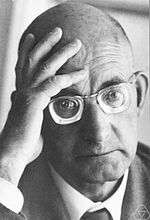Pavel Alexandrov
| Pavel Sergeyevich Alexandrov | |
|---|---|
|
Pavel Sergeyevich Alexandrov | |
| Born |
7 May 1896 Bogorodsk, Moscow Governorate, Russian Empire |
| Died |
16 November 1982 (aged 86) Moscow, Soviet Union |
| Nationality | Soviet Union |
| Fields | Mathematics |
| Alma mater | Moscow State University |
| Doctoral advisor |
Dmitri Egorov Nikolai Luzin |
| Doctoral students |
Aleksandr Kurosh Lev Pontryagin Andrey Tychonoff |
Pavel Sergeyevich Alexandrov (Russian: Па́вел Серге́евич Алекса́ндров), sometimes romanized Paul Alexandroff or Aleksandrov (7 May 1896 – 16 November 1982), was a Soviet mathematician. He wrote about three hundred papers, making important contributions to set theory and topology. In topology, the Alexandroff compactification and the Alexandrov topology are named after him.
Biography
Alexandrov attended Moscow State University where he was a student of Dmitri Egorov and Nikolai Luzin. Together with Pavel Urysohn, he visited the University of Göttingen in 1923 and 1924. After getting his Ph.D. in 1927, he continued to work at Moscow State University and also joined the Steklov Mathematical Institute. He made lifelong friends with Andrey Kolmogorov, about whom he said: "In 1979 this friendship [with Kolmogorov] celebrated its fiftieth anniversary and over the whole of this half century there was not only never any breach in it, there was also never any quarrel, in all this time there was never any misunderstanding between us on any question, no matter how important for our lives and our philosophy; even when our opinions on one of these questions differed, we showed complete understanding and sympathy for the views of each other."[1] According to some researchers, the two were involved in a homosexual relationship in the 1930s,[2][3] while others deny this and suppose that this rumour was spread in the 1950s in order to rehabilitate them as the participants of the Luzin affair.[4]
Alexandrov was an active participant in the political offensive against Luzin which is known as the Luzin affair (1936). According to some sources, he was pressured to denounce Luzin and later Aleksandr Solzhenitsyn in order to prevent official notice of his lifelong homosexual relationship with Andrey Kolmogorov.[5][6]
He had a number of students, including Aleksandr Kurosh, Lev Pontryagin and Andrey Tychonoff. He was made a member of the Russian Academy of Sciences in 1953.
Pavel Alexandrov should not be confused with Aleksandr Danilovich Aleksandrov, another 20th century mathematician who was mainly active in Leningrad.
Books
- Aleksandrov, P. S. (1961). Elementary concepts of topology. New York: Dover. ISBN 9780486607474.
- Aleksandrov, P. S. (1998). Combinatorial topology. Mineola, N.Y: Dover Publications. ISBN 9780486401799.
- Aleksandrov, P. S. (2012). An introduction to the theory of groups. Mineola, N.Y: Dover Publications. ISBN 9780486488134.
Honours and awards
- Hero of Socialist Labour
- Stalin Prize
- Order of Lenin, six times (1946, 1953, 1961, 1966, 1969 and 1975)
- Order of the October Revolution
- Order of the Red Banner of Labour
- Order of the Badge of Honour
Notes
- ↑ Vitányi, P.M.B. (1988). "Andrei Nikolaevich Kolmogorov". CWI Quarterly. Centrum Wiskunde & Informatica. 1 (2): 3–18.
- ↑ Lorentz, G.G. (December 2001). "Who Discovered Analytic Sets?". The Mathematical Intelligencer. 23 (4): 31. doi:10.1007/BF03024600.
In Leningrad, many mathematicians believed that Aleksandrov was homosexual...
- ↑ Graham, Loren R.; Kantor, Jean-Michel (2009). Naming infinity: a true story of religious mysticism and mathematical creativity. Harvard University Press. p. 185. ISBN 978-0-674-03293-4.
The police soon learned of Kolmogorov and Alexandrov's homosexual bond, and they used that knowledge to obtain the behavior that they wished.
- ↑ Kutateladze S.S., The Tragedy of Mathematics in Russia
- ↑ Graham, Loren; Kantor, Jean-Michel (2009), Naming Infinity: A True Story of Religious Mysticism and Mathematical Creativity, Harvard University Press, p. 185, ISBN 9780674032934
- ↑ Szpiro, George (2011), Pricing the Future: Finance, Physics, and the 300-year Journey to the Black-Scholes Equation, Basic Books, p. 152, ISBN 9780465022489
External links
- O'Connor, John J.; Robertson, Edmund F., "Pavel Alexandrov", MacTutor History of Mathematics archive, University of St Andrews.
- Pavel Alexandrov at the Mathematics Genealogy Project
- The 1936 Luzin affair – from the MacTutor History of Mathematics archive
- Lorentz G.G., Mathematics and Politics in the Soviet Union from 1928 to 1953
- Kutateladze S.S., The Tragedy of Mathematics in Russia
